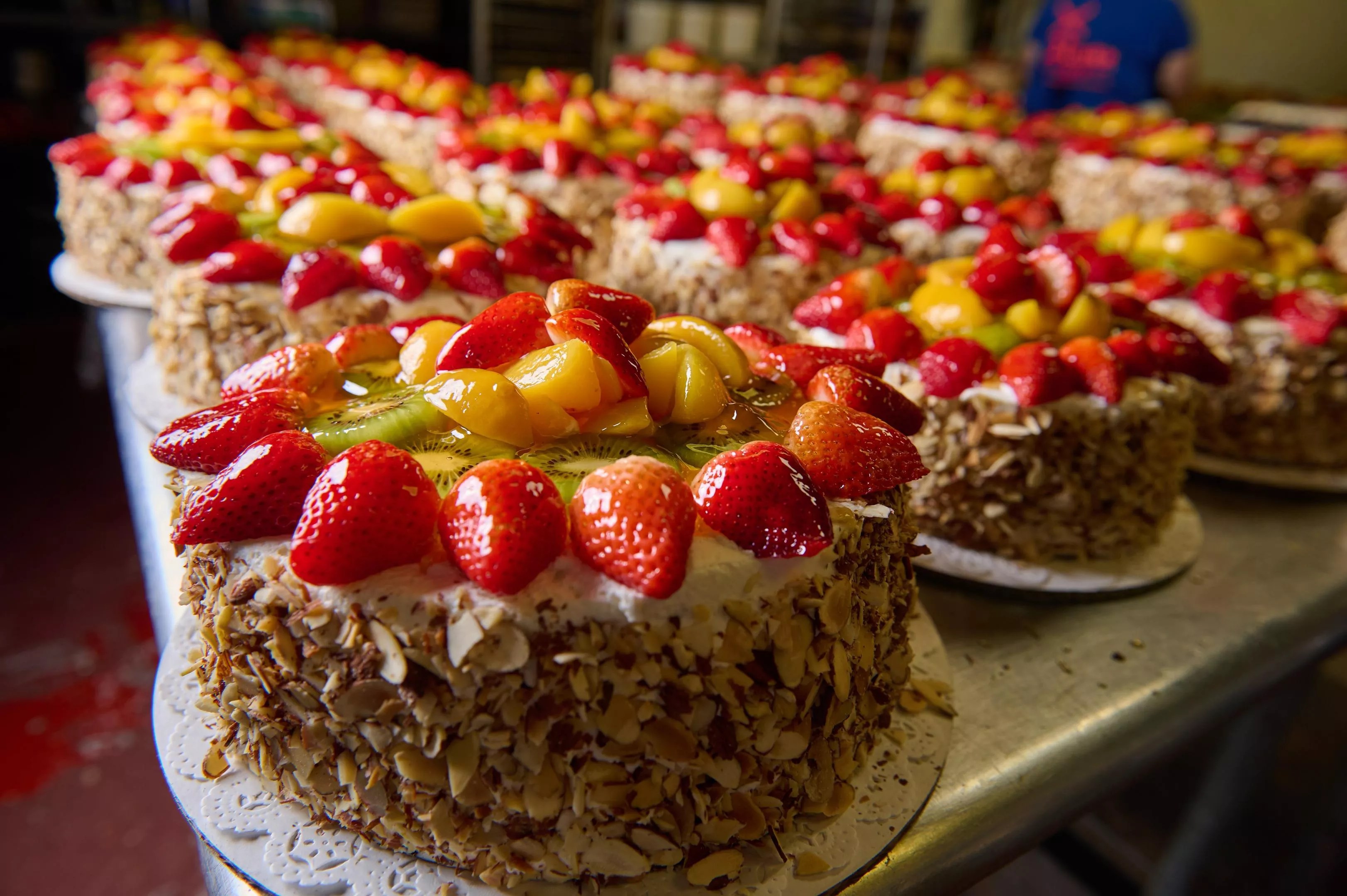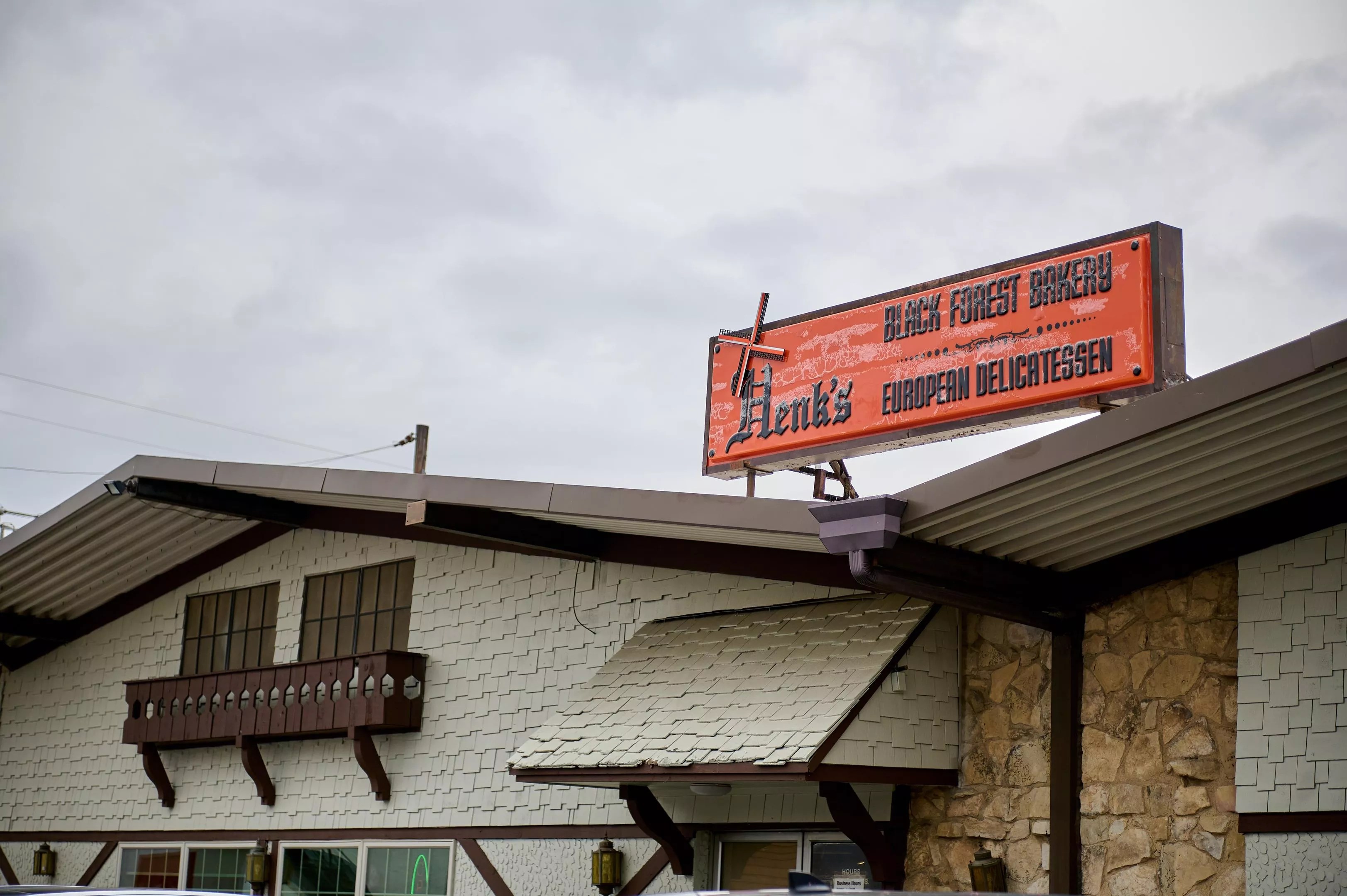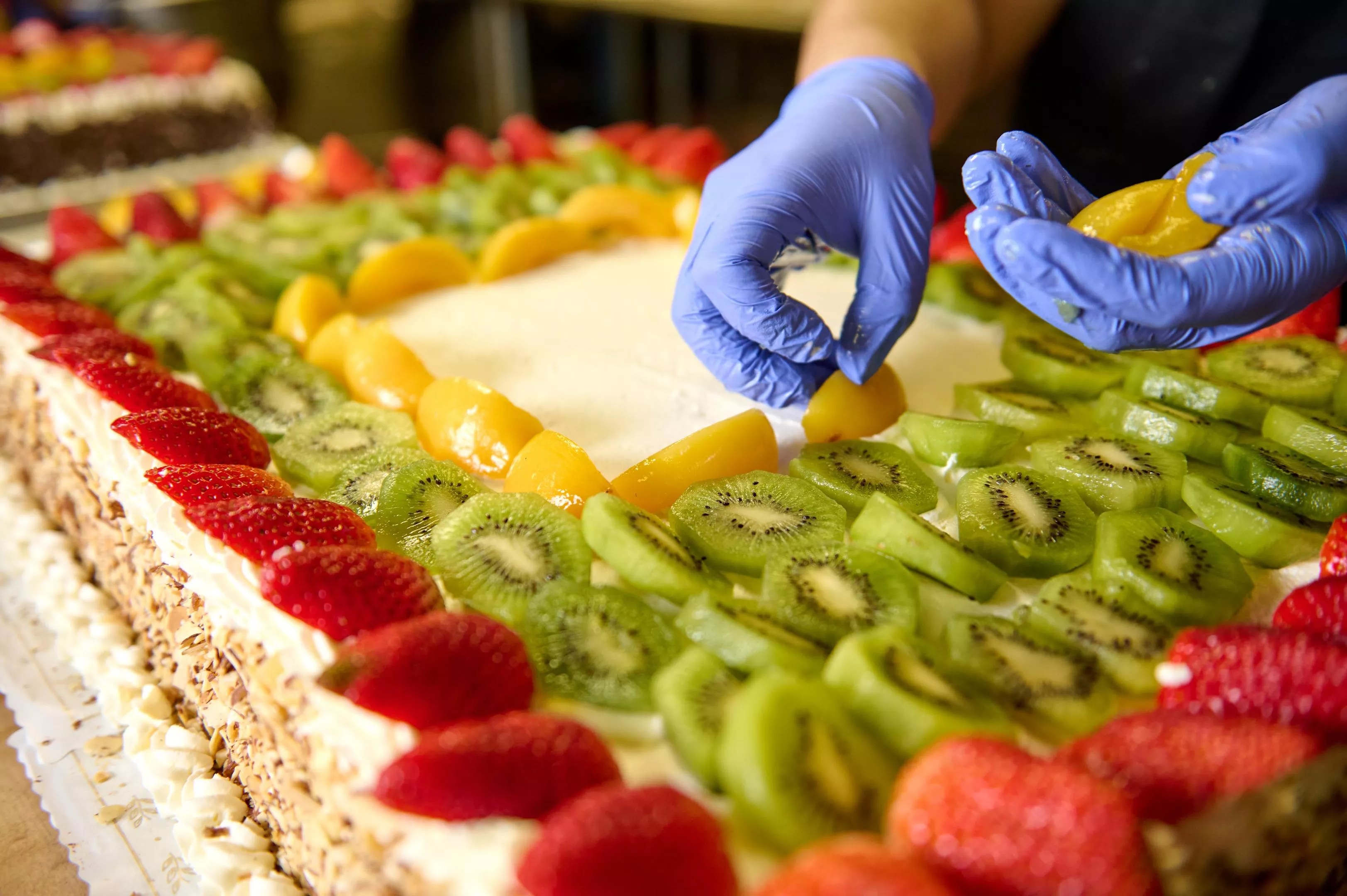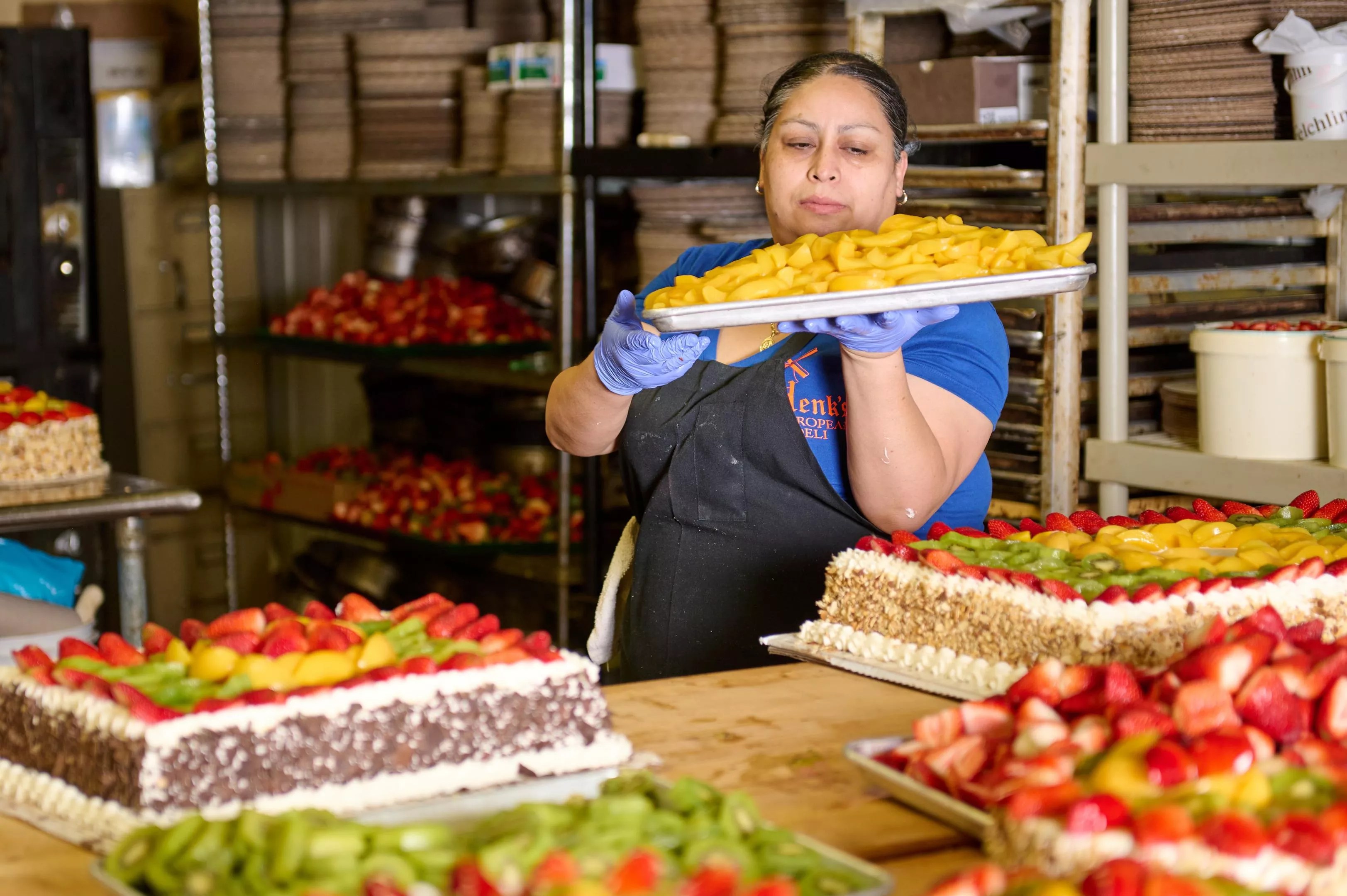
Alison McLean

Audio By Carbonatix
Henk’s European Deli and Black Forest Bakery is tucked away behind the Half-Price Books’ mothership off Loop 12 near Central Expressway. On Saturdays, cars jostle for parking spots in the slightly haphazard lot. People hold the front doors open while others carry double-wide white boxes to their cars, setting them down gently before buzzing off to a party or family gathering.
Henk’s is a restaurant on one side and a bakery on the other, with a small market of European sweets and accoutrements in the middle. A Dutch windmill on the orange sign above the door is a tribute to Hendricus Fransiscus “Henk” Winnubst, a native of Holland whose family has owned the spot since 1991. As soon as you walk in, a sign points customers to where the line forms for the bakery. The space is a bit tight with little room for wandering about.

The Black Forest Bakery has been around since the ’60s, although Henk’s and the Dutch windmill were added in the ’90s. The cake, fortunately, has stayed the same.
Alison McLean
The restaurant serves traditional German food for breakfast and lunch: sausage plates, brats and wiener schnitzel. Behind the counter of the restaurant are several beer taps, all pouring European brews into big steins. The restaurant has been here in one form or another since the ’60s, without much updating. It feels a bit kitschy, like Clark Griswold might walk through the door wearing lederhosen.
This year, make your gift count –
Invest in local news that matters.
Our work is funded by readers like you who make voluntary gifts because they value our work and want to see it continue. Make a contribution today to help us reach our $30,000 goal!
Winnubst died in 2014, and now his sons Adrian and Hubertus co-own the space and can be found slicing meats at the deli, working in the kitchen, ringing up the cash register or even decorating a cake if need be, along with their sister Hanneke Alven.
While German fare is on the menu and the shelves, one particular cake has lured generations of people from all walks of life to this small, family-owned spot. One day a customer dining in the restaurant was admiring the many fancy North African-style dresses worn by customers on the bakery side.
“This looks like the United Nations when I come in here and see all these people picking up cakes,” the customer said to Adrian.
It may or may not be the U.N. of cake, but it’s certainly the cake of Dallas.
••••
A call went out on Facebook recently. Dallas native and Mexican-American Soraya Santos posed a question:
“How did this cake from Henk’s European Deli & Black Forest Bakery get our people in a CHOKEHOLD?! For DECADES, every birthday party, anniversary – ANY family celebration I’ve gone to with my Mexican-American family and friends has served this cake!”
The cake applying this chokehold is the Swiss Madrisa, a simple white sponge covered in whipped cream and topped with a glossy crown of fresh fruit. And, yes, many of those lingering in front of the display case on any given day are Hispanic, but that’s just one of many layers here.
Daniel Dreyfus trained as a pastry chef in his native Switzerland before immigrating to Dallas, where he met his wife, Elvira, who was from Kolsters, a village in the Swiss Alps near the mountain, Madrisa. Daniel worked at the Sheraton downtown when they met. They opened a wholesale bakery business in 1961 and expanded to a retail shop, then eventually a restaurant and market.
Their daughter, Nicole Sanders, still lives in Dallas and grew up working behind the counter with a bouncing blond pigtail and wearing her soccer uniform after Saturday games. She remembers the cake being called an “assorted fruit cake” at the time and thinks that one of the two brief owners before the Winnubsts bought the spot must have anointed it Swiss Madrisa in honor of her parents.
For Sanders, the enduring legacy of this cake and tradition among so many families in Dallas is, she says, “Wonderful.” Her father passed away when she was just 13 years old and her mother died 20 years ago – this cake is a tie to her childhood.
“We had that cake at every special family occasion too,” Sanders says of growing up. “When my daughter turned 1, we got that cake, just as my sister and I did for our first birthdays. We have photos of all three of us with that cake on our first birthdays.”
As for the recipe, she attributes it to her father’s experience as a baker: It’s a simple, universal and light cake with beautiful glazed fresh fruit on top.
When Henk Winnubst, an original co-founder of Kuby’s Sausage House in Snider Plaza, bought the restaurant in 1991, he inherited the recipe for the Swiss Madrisa … and all its lore.
In the early days, Hubertus says, they sold a few cakes a day and were able to keep pace with a small bakery in the back of the shop.
“And then word just got out. I dunno,” he says with a shrug. “Slowly but surely, every year it’s been more and more.”
And by more and more, he means in the neighborhood of 30,000 cakes a year.
So, they added a door to an adjacent space that Whole Foods had used as a bakery for a while, and the cake opera got much bigger. Now eight full-time employees arrive before sunrise to bake and assemble around 700 cakes each week, which includes peeling and slicing 400 cases of kiwi and cracking 9,000 eggs. Two industrial mixers the size of R2D2 whip 60 cases of cream into sweet fluffy clouds.

After cakes are covered in whipped cream, they get a quick run through the slivered almond station.
Alison McLean
After each cake is baked and cooled, it’s sliced into three layers before being married back together with layers of whipped cream and fruit. The sides and top are coated with more whipped cream before each heads to the almond station, where the sides are softly patted with slivered almonds.
Next, every cake waits on a table for bakers to top with fruit: a ring of strawberries on the outside, then kiwi, and peaches in the center with a few more strawberries on the top. The final touch is a layer of house-made syrup giving it a glossy pop.

The finall touch.
Alison McLean
Everyone works fast and most have been here for a while. Sisters Mary and Chayo Gamez have worked in the bakery for about two decades, and Juan Rodriguez has been there for 34 years. There’s conversation and a lot of laughs between them as they make these delicacies every morning, but they stay focused and moving. There’s simply too much to do.
By 7 a.m. on most days, a hundred or so cakes are all dolled up and ready for center stage, wherever that may be. Some are loaded onto racks and pushed into one of three walk-in coolers, while others are set in display cases. By opening time at 8 a.m., special orders are being hauled out with “Happy Anniversary” or “Feliz Cumpleanos” written on top. These are the big two-handed cakes.
By 9 a.m., most of the Swiss Madrisas are done, and the chocolate cakes start filling up the tables for the second movement of this opera – lest we forget the Swiss Madrisa isn’t the only cake at this bakery. Their chocolate strawberry cream cake certainly is no slouch.

Each cake is topped with fruit, then a layer of glossy syrup for a nice finish.
Alison McLean
Around noon, they’re prepping for the next day, peeling and slicing boxes of fruit. This, too, is fast and focused.
On Christmas Eve last year, Henk’s sold 770 Swiss Madrisa cakes in one day. On Mother’s Day, their busiest day, they prepare around 1,200 cakes. Be it Eid al-Fitr, Christian holidays or celebrations for communities from North Africa, Europe, Asia and Latin America – come one, come all – they line up for this cake.
And while other grocery stores sell similar-looking cakes, the texture and consistency is always different. For instance, Fiesta Mart’s fruit-topped white cake is a tres leches with dense, moist layers. H-E-B sells a comparable cake as well – white icing with fruit on top – but the ones we found were also tres leches, even denser than the Fiesta Mart variety.
Other European delis and Black Forest bakeries around the U.S. have equivalent cakes, like Freed’s in Las Vegas and Nadler’s in San Antonio. None are called “Swiss Madrisa,” despite seemingly being the same: whipped cream, a light sponge, fresh fruit and slivered almonds on the sides.
While the cake’s origins are in Europe, how it became so appealing to so many communities is difficult to trace. The Winnubsts aren’t exactly sure either. Perhaps it’s the simplicity. Instead of fondant or overly sweet, brightly colored icing, whipped cream is topped with fresh fruit. Visually, the cake is a sunny day. Fresh, light and happy. The price is also tempting. The small round 8-inch cake is $37 and easily provides 10 robust slices.
“I’ve asked people in the past,” Hubertus says. “They say, ‘This is the taste of our country. This is what you find in Mexico City.'”

The Swiss Madrisa has been a part of Soraya Santos’ family celebrations since at least the ’70s.
Soraya Santos
Santos’ mother immigrated from Merida, the state capital of Yucatan, to Dallas in 1963. Her family was part of a Mexican immigrant community on Lower Greenville that in the ’60s, ’70s and ’80s leaned on each other, especially business proprietors who were friendly and fair to the Hispanic community, she says. And since the ’70s, she remembers two cakes at all celebrations.
“One usual super-sweet sheet cake covered in frosting for the kids,” she says, “and Henk’s Swiss Madrisa fruit-covered cake for the grown-ups. I don’t remember when they showed up. They were just always there.”
For decades, it wasn’t just at her house. Every family gathering or party had a Swiss Madrisa. Recently she went to another community event, and there it was again. For her son’s birthday parties, she still orders Henk’s for the adults and a grocery store sheet cake for the kids.

Hundreds of pounds of fruit are peeled and sliced weekly, although the peaches are from a can. Some alterations are requested for some cakes, like chocolate chips instead of almonds.
Alison McLean
Recently a Reddit user posted a generic photo of a fruit-topped cake and asked where he could find one in North Austin. People responded with H-E-B and Whole Foods, but then someone suggested Henk’s.
“Thanks for confirming my suspicions, I am 99.99% sure that was the bakery my family used to get birthday cakes from! Looking at pictures of the storefront is jogging up memories I had from years ago when I visited as a kid; glad to see it’s still there.”
It’s not just the cake either. It’s the friendly environment at Henk’s. The owners, in our experience, seem genuinely happy to be there, which sets the mood for employees.
“They are just great people too,” Santos says. “More than once I’ve gone in a panic, having forgotten to order a cake, and they can have one ready for me right away, personalized with ‘Happy Birthday’ or ‘Congratulations’ or whatever on its icing banner.”
Even the pandemic couldn’t keep customers away. Hanneke remembers when social-distancing mandates were in place and a long line snaked out their door and through the parking lot on Mother’s Day weekend.
“I remember watching this one guy who had a white shirt,” she says. “When he came in and paid, I was like, ‘So how long did you wait for this cake?’ He said, ‘An hour and a half.’ I looked at him and he goes, ‘It’s worth it.'”
When asked about possibly expanding this cake empire, Hubertus says with a touch of humor they could probably be millionaires if they could figure it out. But with family and dogs at home, and thousands of cakes a month already, it’s a lot of work.
“My dad used to have this saying, ‘One business, one headache. Two businesses, two headaches,'” Hubertus says.
Besides, there’s only one U.N.
And one cake of Dallas.